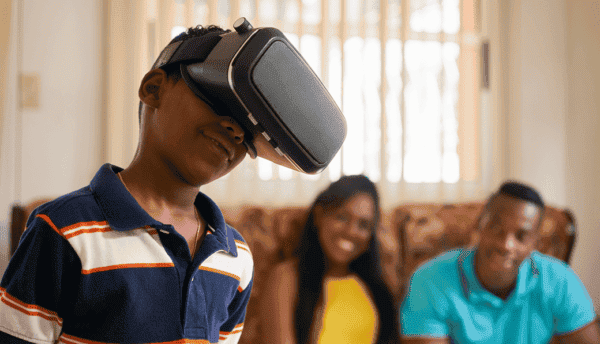Virtual Reality, usually referred to as VR, used to be the preserve of science fiction films. Now, though, a range of VR gaming products offer new ways to enter the gaming world.
Players wear a VR headset and see the virtual environment from a first person perspective. As they turn their heads and move around the world moves accordingly. This creates a very immersive experience.
Hardware Choices
There are a range of different VR products. The main options are Oculus Rift, Gear VR, HTC Vive and PlayStation VR. There are differences with each of these in terms of how the systems deliver their VR experience, but the basic concept is the same throughout.
The technology employed and cost also differ. Oculus Rift and HTC Vive need to a powerful PC to work, while the PlayStation VR uses a PlayStation 4. Gear VR, on the other hand, works with most higher specification Android smartphones.
Finally, Google Cardboard is the cheapest VR option. This Google-developed technology holsters a phone in a cardboard holder that players place in front of their eyes. The approach and tech have been used by other products like Mattel’s View-Master.
Finding the right device for a family requires some consideration. Cost should be a factor here as the systems vary greatly. It can be helpful to try cheaper experiences on Google Cardboard or Gear VR. If these games work well for your family then you can consider more investment in something with a higher specification.
PEGI Rating
As with any video-game sold in the UK, VR games have a PEGI rating to advise parents of the content they contain. Although there is the perception that VR games create a more immersive experience, the content is currently rated in the same way as traditional games.
The GRA stated that “at present, the PEGI ratings continue to reflect content issues rather than issues set around technological improvement in gaming hardware”.
The PEGI ratings can be particularly useful for VR games, however, as it can be harder to see what the player is experiencing. The industry-funded AskAboutGames.com and statutory rating body websites provide additional information here. In particular, they list the detail of why a particular game has a particular rating.
VR Health & Safety
Bringing any new technology into the home requires some thought about its safety and healthy enjoyment. There is plenty of guidance provided for each of the VR offerings; follow this and VR can be a hugely positive part of gaming in the home.
Each of the different systems come with a recommended minimum age for players. This advice focuses on limiting time and access to children whose eyes are still developing. Gear VR and Oculus Rift both have a 13+ rating. The PlayStation VR states that it is for children who are 12 years old and up.
The HTC Vive includes guidance that young children shouldn’t use the product, although it doesn’t specific an exact age. The Oculus guide echoes this advice with its statement that “younger children are in a critical period in visual development”.
More generally, the systems should be setup and played with plenty of space around them. Cables and furniture can cause an unexpected trip hazard during play should be tidied away. Also, you should ensure that the headsets are comfortably fitted to the head.
Beyond specific cautions around the technology itself, parents should apply the same approach as with other video-games to ensure the family gets the most out of VR gaming. Trying the games out before younger players experience them is advisable. The PlayStation VR is particularly helpful in this respect as parents can see what the player is seeing, mirrored to the Television.
Finally, as with any video-game, you should take breaks of 5-10 minutes after every 45 minutes of playing. Starting with shorter periods of play is also advisable to let players acclimatise to this very different way of playing games.
Some people report that the VR experience can trigger feelings of nausea. This varies person to person, depending on sensitivity and the game being played. The PlayStation VR guide is helpful here. It states that “in many cases, initial discomfort experienced can fade as you acclimate to VR gameplay”.
Learn more about the VR devices:
Click on the links to view the users’ guide for the devices.
Online Features
While online interactions with other people are not something new, the inclusion of this feature in VR games should be considered by parents when selecting content for their family. These interactions can greatly enhance the experience of VR games but, as always, parents should be mindful of potential dangers here too.
Because it is difficult to see the interactions a player is having in a VR game, a little more care and consideration is warranted. Settings are provided to enable or disable these features in each of the systems. These should be applied as you would any other device. Again, one of the best ways to allay fears with online play is to try the games out before younger members of the family play them.
Conclusion
Although the new and novel technology may trigger concerns for parents, setup and used appropriately VR Gaming can be a hugely positive experience for the family. Not only does it offer a new way to play games together but it also develops new skills and understanding in a variety of challenges.





